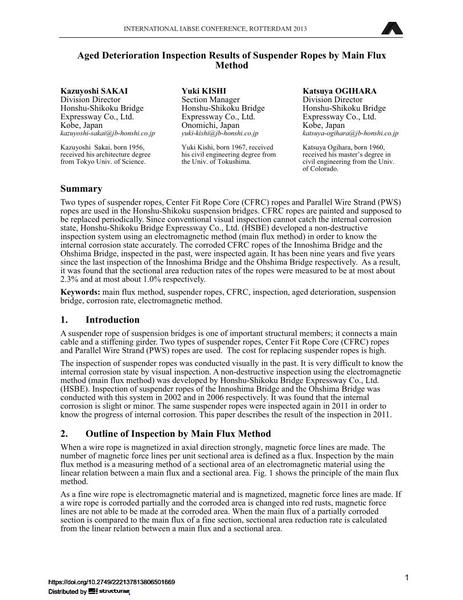Aged Deterioration Inspection Results of Suspender Ropes by Main Flux Method

|
|
|||||||||||
Bibliographic Details
| Author(s): |
Kazuyoshi Sakai
Yuki Kishi Katsuya Ogihara |
||||
|---|---|---|---|---|---|
| Medium: | conference paper | ||||
| Language(s): | English | ||||
| Conference: | IABSE Conference: Assessment, Upgrading and Refurbishment of Infrastructures, Rotterdam, The Netherlands, 6-8 May 2013 | ||||
| Published in: | IABSE Conference, Rotterdam, May 2013 | ||||
|
|||||
| Page(s): | 370-371 | ||||
| Total no. of pages: | 8 | ||||
| Year: | 2013 | ||||
| DOI: | 10.2749/222137813806501669 | ||||
| Abstract: |
Two types of suspender ropes, Center Fit Rope Core (CFRC) ropes and Parallel Wire Strand (PWS) ropes are used in the Honshu-Shikoku suspension bridges. CFRC ropes are painted and supposed to be replaced periodically. Since conventional visual inspection cannot catch the internal corrosion state, Honshu-Shikoku Bridge Expressway Co., Ltd. (HSBE) developed a non-destructive inspection system using an electromagnetic method (main flux method) in order to know the internal corrosion state accurately. The corroded CFRC ropes of the Innoshima Bridge and the Ohshima Bridge, inspected in the past, were inspected again. It has been nine years and five years since the last inspection of the Innoshima Bridge and the Ohshima Bridge respectively. As a result, it was found that the sectional area reduction rates of the ropes were measured to be at most about 2.3% and at most about 1.0% respectively. |
||||
| Keywords: |
suspension bridge inspection corrosion rate main flux method suspender ropes CFRC aged deterioration electromagnetic method
|
||||
